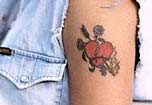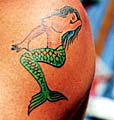Tattoos
Tattoos Aren’t New of Course…
Tattooing has been around since ancient times and its presence in our mainstream society is not going to fade away anytime soon. In three percent of American households today, at least one of their members has one or more tattoos. At least twelve million Americans have one tattoo.
This decorative art form continues to be a growing attraction to teenagers. Teens as young as 13 and 14 are getting their first tattoos. It isn’t just guys who are getting them, over the past twenty years the number of women getting tattoos has quadrupled.
 The color additives used in tattooing pigments are the same as those used in cosmetics. They are monitored by the U.S. Food and Drug Administration and approved for topical application only. There are more than 100 different color variations, but the most common colors are red, green, yellow, blue and white. White is used to mix colors to make color variations.
The color additives used in tattooing pigments are the same as those used in cosmetics. They are monitored by the U.S. Food and Drug Administration and approved for topical application only. There are more than 100 different color variations, but the most common colors are red, green, yellow, blue and white. White is used to mix colors to make color variations.
Tattooing Technique
 Permanent tattoos are applied by injecting the color pigments mention above into the skin using a solid, round-tip needle attached to a motorized instrument that holds up to 14 needles attached to the pigments. The pigments are injected into the middle layer of the skin at a rate of 15 to 3,000 times per minute.
Permanent tattoos are applied by injecting the color pigments mention above into the skin using a solid, round-tip needle attached to a motorized instrument that holds up to 14 needles attached to the pigments. The pigments are injected into the middle layer of the skin at a rate of 15 to 3,000 times per minute.
Most tattoo artists use an electrically powered, vertical, vibrating instrument to inject the tattoo pigment. The instrument injects pigment at 50 to 30,000 times per minute into the second layer of skin, at a depth of 1/64 to 1/16 of an inch. A single needle outlines the tattoo and the design is then filled in with five to seven needles in a needle bar.
In other cases, tattoo artists apply the tattoo by hand dipping a needle into pigment, without the use of an electric instrument. Depending upon the complexity of design, the process takes anywhere from fifteen minutes to several hours or sometimes months to complete.
 Remember, a tattoo is forever. Some people may think that it is a way to express their individuality. Some people see it as an art form. But before you walk into a tattoo studio, you should know exactly what you want to put on your body. After you have decided, you will need to find the right artist to do the work. Choose someone with a good reputation; someone whose work you have seen on your friends or other people.
Remember, a tattoo is forever. Some people may think that it is a way to express their individuality. Some people see it as an art form. But before you walk into a tattoo studio, you should know exactly what you want to put on your body. After you have decided, you will need to find the right artist to do the work. Choose someone with a good reputation; someone whose work you have seen on your friends or other people.
State health departments in Texas, Oregon and Wisconsin monitor and inspect tattoo studios. However, tattoo studios operate in many states in the U.S. but are NOT inspected by a local health department. New York City currently has over 400 licensed tattoo artists. Tattoo studios are still illegal in several states in the US: Vermont, Massachusetts and Oklahoma being a couple at the time of this writing.
 A good artist will take the time to sit down with you and create an individual work of art. A questionable artist might encourage you just to pick a design off of his wall. Check out the studio. It should be equipped with an autoclave — a device that pressurizes the instruments and kills any viruses or bacteria. Does the artist use single-use or disposable needles? Single-use needles are a higher quality needle than a disposable.
A good artist will take the time to sit down with you and create an individual work of art. A questionable artist might encourage you just to pick a design off of his wall. Check out the studio. It should be equipped with an autoclave — a device that pressurizes the instruments and kills any viruses or bacteria. Does the artist use single-use or disposable needles? Single-use needles are a higher quality needle than a disposable.
Don’t get your tattoo at a “bargain rate” in some sleazy part of town. Remember, this will be on your body FOREVER. Yes, they can be removed with a laser, more on that below. It can be a very expensive price to pay to remove an inexpensive tattoo and a painful one at that. More on removal below too.
Summer tattoo note: To keep your tattoo color from fading, protect it with a good sunscreen or use a specially designed tattoo color guard .
Potential Complications
 The actual incidence of complications related to tattooing is not known. There are amateur artists, do-it-yourself ers, and informal tattooers, known as “scratchers” who are not required to report complications. Also just because a tattoo parlor is in business doesn’t mean it is maintaining safety and sterility precautions. Bleeding, pain and some discomfort are to be expected. The intensity of pain from a tattoo depends upon the location and size. If not properly cared for during the first two weeks the area has the potential for infection and scarring.
The actual incidence of complications related to tattooing is not known. There are amateur artists, do-it-yourself ers, and informal tattooers, known as “scratchers” who are not required to report complications. Also just because a tattoo parlor is in business doesn’t mean it is maintaining safety and sterility precautions. Bleeding, pain and some discomfort are to be expected. The intensity of pain from a tattoo depends upon the location and size. If not properly cared for during the first two weeks the area has the potential for infection and scarring.
Medical literature cites reports of gangrene, syphilis, TB, contraction of hepatitis B from contaminated instruments and hypersensitivity to the pigments to name a few complications. The CDC is concerned about the transmission of HIV. The risk for HIV transmission is always present when a contaminated instrument pierces the skin. (Although the virus that causes HIV dies at room temperature and a germicidal soap is enough to eliminate it, the potential for transmission should not be ignored). These risks can be eliminated if you go to a state licensed facility that is following the correct sterilization guidelines.
Tattoo After Care Instructions
The following directions are from a licensed tattoo artist that I interviewed for this article near where I live in Florida. I asked him about after care and this is what he told me to pass along to CN readers. (Tattoo parlors are very prevalent here, maybe because we spend most of the year with our skin showing, just an FYI).
Tattoo aftercare is vital to the longevity of your tattoo! How your tattoo looks three months or three years from now depends upon how you treat it right away. Follow these steps to promote a healthy tattoo.
 Remove the bandage after 4 to 12 hours. (Depending upon the size and location of the tattoo). Do not re-bandage. Wash your tattoo with warm water and an antibacterial soap. Gently pat dry with a clean towel. Apply a thin layer of triple antibiotic ointment. Use the ointment during the first two days, 3 or 4 times a day. Make sure your hands are clean before touching your tattoo. After the first two days, apply a thin layer of fragrance free moisturizing lotion. Apply it 3 to 4 times daily for the next 2 to 3 weeks. A fragrance free, natural lotion is preferred, Aveeno is good. The normal healing time is 2 to 4 weeks. Do NOT pick or scratch your tattoo. Flaking or peeling is a natural part of the healing process.
Remove the bandage after 4 to 12 hours. (Depending upon the size and location of the tattoo). Do not re-bandage. Wash your tattoo with warm water and an antibacterial soap. Gently pat dry with a clean towel. Apply a thin layer of triple antibiotic ointment. Use the ointment during the first two days, 3 or 4 times a day. Make sure your hands are clean before touching your tattoo. After the first two days, apply a thin layer of fragrance free moisturizing lotion. Apply it 3 to 4 times daily for the next 2 to 3 weeks. A fragrance free, natural lotion is preferred, Aveeno is good. The normal healing time is 2 to 4 weeks. Do NOT pick or scratch your tattoo. Flaking or peeling is a natural part of the healing process.
 Do not soak your tattoo during healing. That means no baths, hot tubs, pools, etc. Keep your tattoo out of direct sunlight while it’s healing. After your tattoo is healed, always use sun block while in the sun, preferably 30 to 45 SPF. Tattoos Do fade over time. Remember to moisturize your skin with lotion. This will help keep your colors fresh. Please consult a physician at any sign of infection or allergic reaction and report any infection or allergic reaction to the tattooist and your State Department of Health in the USA.
Do not soak your tattoo during healing. That means no baths, hot tubs, pools, etc. Keep your tattoo out of direct sunlight while it’s healing. After your tattoo is healed, always use sun block while in the sun, preferably 30 to 45 SPF. Tattoos Do fade over time. Remember to moisturize your skin with lotion. This will help keep your colors fresh. Please consult a physician at any sign of infection or allergic reaction and report any infection or allergic reaction to the tattooist and your State Department of Health in the USA.
Tattoo Removal
There are various methods of tattoo removal. The removal method depends upon the pigment used, the amount of time the tattoo was on the skin, the size, location and whether or not it was done professionally. It is important to remember that it costs more to remove a tattoo than to apply one. Since it is an elective procedure it is not covered by most health insurance companies. Total removal of a tattoo is not always possible. In the U.S. dermatologist’s estimate that 400,000 people will have their tattoos removed this year.
Common Removal Methods
 Surgical removal may be an option for small tattoos. Surgery also can be used for the removal of larger tattoos, but this may involve the need for multiple surgeries and skin grafting.
Surgical removal may be an option for small tattoos. Surgery also can be used for the removal of larger tattoos, but this may involve the need for multiple surgeries and skin grafting.
Dermabrasion is another removal method, which involves freezing the skin, then sanding the surface with an abrasive instrument. Because the pigments are located in the middle of the skin, pain, bleeding and or discomfort can be expected.
Salabrasion is a similar procedure, bur requires the application of an irritating substance prior to sanding. This position can take 30 – 60 minutes depending upon the location and size of the tattoo.
 Laser treatment, whereby light is amplified by stimulated emission radiation, is a popular removal method. Its effectiveness is dependent on the targeted pigment. These instruments emit highly focused light beams that break up the pigment particles, which then evaporate.
Laser treatment, whereby light is amplified by stimulated emission radiation, is a popular removal method. Its effectiveness is dependent on the targeted pigment. These instruments emit highly focused light beams that break up the pigment particles, which then evaporate.
The laser beam feels as if a rubber band is being snapped against the skin. Crusting at the tattoo site results and the tattoo will gradually fade as healing takes place.
The effectiveness of this method is compromised if the person has a deep tan. In some cases the multiple treatment sessions may be required for complete removal. The average cost for complete removal can vary, but the average range for removal of a 2-square-inch tattoo is $900 -$1500.
Before You Tattoo?
 If a person is considering getting a tattoo, they should know what to look for when inspecting a tattoo establishment. People need to look for basic equipment such as germicidal soap, needle buckets, proper disposal containers, packaged gauze with the sterility intact, disposable gloves. Does the studio appear to be clean?
If a person is considering getting a tattoo, they should know what to look for when inspecting a tattoo establishment. People need to look for basic equipment such as germicidal soap, needle buckets, proper disposal containers, packaged gauze with the sterility intact, disposable gloves. Does the studio appear to be clean?
Besides a visual inspection, ask the tattoo artist if he or she is a member of a national tattoo organization. The Alliance of Professional Tattooing is a nonprofit organization that monitors legislation and keep artists updated on safety issues.
Talking to the tattoo artist can give you an idea of the artist’s knowledge of safety, infectious disease transmission and prevention.
So, Before Getting Tattooed, (if you are of age of course)…
- PLEASE: Do not get a tattoo if you are sick or not feeling well. Wait until you’re feeling better before getting that tattoo.
- Make sure you’ve had food and rest. Getting tattooed on an empty stomach or drunk may cause you to feel faint, nauseated, or dizzy.
- Don’t take pain killers like aspirin, ibuprofen, and anesthetics, which may possibly cause cause problems, such as increased bleeding.
- Do not get tattooed if you are under the influence of drugs or alcohol.
You must be over 18 years of age with a valid, government issued photo ID in most states. Call your local department of health if you are not sure of the age requirement or if you think the tattoo artist might be lying.
 As I stated earlier, there is a lot of follow-up care after having a tattoo. Make sure you are informed by the tattoo artist before getting one. Antibiotic ointment must be used, you can buy it over the counter, but the tattoo artist must tell you how to care for it before you get it, otherwise leave and go somewhere else. There are sites on the web which tell you how to help the tattoo heal properly. If you do decide that you really want one, talk to your parents about the decision. Perhaps they have one or two that they wish they never got put on. Listen to their opinion and see what they have to say, they might just surprise you.
As I stated earlier, there is a lot of follow-up care after having a tattoo. Make sure you are informed by the tattoo artist before getting one. Antibiotic ointment must be used, you can buy it over the counter, but the tattoo artist must tell you how to care for it before you get it, otherwise leave and go somewhere else. There are sites on the web which tell you how to help the tattoo heal properly. If you do decide that you really want one, talk to your parents about the decision. Perhaps they have one or two that they wish they never got put on. Listen to their opinion and see what they have to say, they might just surprise you.
The temporary tattoos that are sold today look real and are a lot more fun because they come off as soon as you want them to. Be careful, take some time to think about this decision. And remember, many girls and guys find tattoos a turnoff!
This article is intended to provide factual information, it is not meant to encourage or discourage your choice about a tattoo if you are of age (Age 18 or older in most states in the U.S.) To read about body piercing… >>
An FYI: Scientists at the CDC are researching a possible link between tattoos and piercings and the infectious liver disease called viral hepatitis. (See our Hepatitis B section under STDs). Piercing any part of your body with a non-sterile needle may put you at risk for contracting hepatitis, which is even more contagious than HIV (the virus that causes AIDS). Like HIV, hepatitis is spread through person-to-person contact with infected blood or other body fluids and there is no cure. Just the facts, it is your body.
FYI: The divisions of ‘Adolescent Medicine’ and ‘ Departments of Pediatrics’ in several major Schools of Medicine, and their Universities have been studying “Tattooing and High-Risk Behavior in Adolescents” and have concluded: “Tattooing was strongly associated with peer substance use”. And… “Adjusting for sociodemographic factors and peer substance use, tattooing in adolescents was independently and significantly associated with reported sexual intercourse, substance use, violent behaviors, and school problems.” (I am not at liberty to give this source of information at this time). I wear temporary tattoos sometimes, where do I fall in this study? 🙂
I have interviewed about 150 teenagers with tattoos and while I am NOT promoting the choice or act of tattooing, I have not found their conclusion to be true at this time. I live within a 3 mile radius of about 5 tattoo establishments. (The Gulf coast of Florida). I personally use temporary tattoos.
Update, January 2003: The CDC is still concerned about the transmission of Hepatitis B and C from tattoo ‘parlors’ that do not use proper sterilization techniques. I did some research here in Florida, as we have many tattoo establishments. They all follow the state guidelines for sterilization and none that I spoke to knew of any cases of transmission from their ‘work’. If you decide to get a tattoo, check the place out first. For more on Hepatitis transmission and Hepatitis A, B, and C… see the “Hepatitis Introduction ” article and video from well-known physicians. Stay Informed. Check out “ Hepatitis C, An Epidemic Ignored”.
To “Body piercing” and healing table >>
- See what the FDA has to say about permanent makeup and some tattoo pigments : (May 18, 2003).
- Check out Tattoos: Think Before You Ink
- Please (a.u.b.) don’t use these images without permission and after It is ok’ d download them to your own server. Otherwise you are stealing our bandwidth and that costs us a lot of money! Please stop doing this. There is one site that I know of in Holland and I wish she would realize this is stealing money from us. Dank u.
